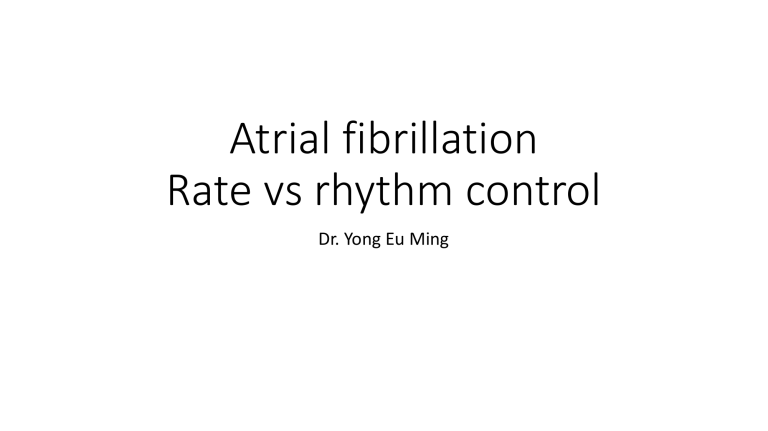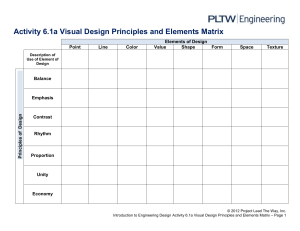
Atrial fibrillation Rate vs rhythm control Dr. Yong Eu Ming Introduction • Atrial fibrillation (AF) is the most common sustained arrhythmia in adults, with approximately 44 million individuals estimated to have AF or atrial flutter worldwide. • AF associated with substantial mortality and morbidity, which poses a significant burden to patients and health care services Current AF management • Management comprises 3 main domains summarized in the ”ABC” scheme of the 2020 ESC AF guideline • A anticoagulation/avoid stroke • B better symptoms control using rate and rhythm management • C therapy of concomitant cardiovascular conditions • Favoring rate control with rhythm control added specifically and primarily to symptomatic patients - (top) Current guidelines, largely recommending initial rate control, with rhythm control added specifically and primarily to symptomatic patients - (right) rhythm control are also reserved for use only in specific patient subgroup who might be expected to benefit from rhythm-control strategy • Guidelines of the recent ESC 2020, data derived from AFFIRM, RACE, AF-CHF, STAF and J-RHYTHM • Overall, few significant differences in important endpoints have been observed between rhythm- and ratecontrol strategies • Meta-analyses however shown fewer hospitalizations were required to deliver simple rate control But why ??? • Maintained of sinus rhythm has itself been associated with reduction in death and cardiovascular events • AADs approximately double likelihood of maintaining sinus rhythm compare with rate control Hospitalizations rates • The current guidelines defaults to initial rate control, as meta-analyse have shown that fewer hospitalizations were required to deliver simple rate control. • They found that in rhythm control arm group, there were more likely to be readmitted for adverse drug effects of AAD and the need for other rhythmcontrol interventions (i.e., left atrial ablation and cardioversion • When treatment adjustments for rhythm control were excluded, hospitalization rates from the AFFIRM analyses were similar in both cohorts. Quality of living (symptoms control) • Difficult to assess with pitfall during trials, because there isn’t a standardized AF-specific tools to assess; in addition to small sample size, short-term follow up periods. • Findings from trials comparing both rate vs rhythm, both arm reported improve QOLs but with little difference between the two • However, recent observational trial, such as CABANA, RECORD-AF and ESCEHRA EORP-AL reported potential QoL benefit of rhythm control. • AF ablation improves QoL more, because of chronotropic incompetence and resulting impairment of effort tolerance due to AAD therapy But why …… • But large landmark trials still reported no significant difference… possible reasons in the recent paradigm shifts. • Trials conducted in 1980s and 1990s, lack of safe and effective therapies • Less stringent monitoring • Inadequate and unbalanced therapies for concomitant medical conditions and anticoagulant therapy • Nowadays, with introduction of ACEI / mineralcorticoids receptor antagonist / SGLT-2i, these are seen to improve maintain of sinus rhythm • Better lifestyle adjustment such as weight loss, management of sleep apnea • AADs doses (inappropriately high or suboptimal) potentially reducing efficacy or inciting proarrhythmic. • Previously used anti-arrthymic were associated with excess mortality likely attributed by AADs pro-arrhythmic or negative inotropic effect • Nowadays, newer drugs are used which are less pro-arrhythmic (dronedarone) • Ablations techniques improving •SO …… Rate or rhythm New evidence supporting rhythm control • ATHEA ATHENA study • Both arms included standard therapy including rate control • Included patients who met >= 1 CHADS2 risk factors, left ventricular EF <= 40%, or left atrial enlargement • Other AADs were not included in this study • Exclusion criteria: HF with NYHA class IV, unstable heart failure patients • Findings: • Dronedarone reduce the risk of primary outcome of hospitalization due to unexpected cardiovascular events or death from any cause compared with placebo • There was a significant reduction in secondary outcomes with dronedarone compared with control, including cardiovascular death (secondary outcome) and stroke *post hoc analysis) Clinical benefit of early Rhythm management - EAST-AFNET 4 study • Study of 2789 patients with AF diagnosed within 12 months before randomization who were at risk of stroke • Trial included patient with these sets of criteria: • Age > 75 years old • Prior transient ischemic stroke • Met 2 of the following: CHADVAS2 >=1, CKD, LVH • 2 arms: • usual care (guideline primary rate control plus OACs with rhythm control added to control symptoms); n = 1394 and • guideline-recommended care plus early rhythm control treatment, consisting typically of AAD therapy or , to a lesser degree ablation; n = 1395 Findings: - Primary outcomes composite of death from cardiovascular causes, stroke (ischemic or hemorrhagic) or hospitalization with worsening heart failure or acute coronary syndrome, which was reduce by 21% in patients assigned to early rhythm control compare with usual care (P = 0.005) - Secondary outcomes in terms of number of stay in hospital, there was no significant difference between both arm Conclusion: - Early rhythm control therapy was associated with lower risk of adverse cardiovascular outcomes than usual care among patients with early atrial fibrillation and cardiovascular condition. AF ablation for rhythm control • Rapid development in ablation, evolving from an experimental procedure to an important treatment option in AF • Complication rate has declined in recent years due to quality improvement initiatives and advancement in technique and technologies • Studies, such as CASTLE-AF, CABANA (ablation > pharmacological) • • • • Lower AF recurrence (37% vs 58% at 1 year-follow up, 50% vs 69% at 3 year) Reduce AF burden improvement in left ventricular ejection function Primary endpoint (death or hospitalization for worsening heart failure) were significantly fewer in the ablation group than in the pharmacological therapy group (P = 0.006) What can we derive from recent studies • Benefits of early rhythm control have been shown for both pharmacological therapy and ablation, to be highly effective especially when used in recent-onset AF • Dronedarone has most extensively studies AAD in terms of rhythm control and adverse cardiovascular outcomes; and has been found to be effective and safe • AADs vs ablation, ablation is more superior • Shorter (< 1year diagnosis) with ablation initiated, have shown to lower risk of AF recurrence. •SO …… Rate or rhythm References (1) Camm A, Naccarelli G, Mittal S, et al. The Increasing Role of Rhythm Control in Patients With Atrial Fibrillation. J Am Coll Cardiol. 2022 May, 79 (19) 1932– 1948.https://doi.org/10.1016/j.jacc.2022.03.337 (2) Stefan H., Harry J., G.M.Crinjns, Martin VE, et al. Effect of Dronedaroen on Cardiovascular events in atrial fibrilations. N Engl J Med. 2009; 360:668-678. https://www.nejm.org/doi/full/10.1056/nejmoa0803778

